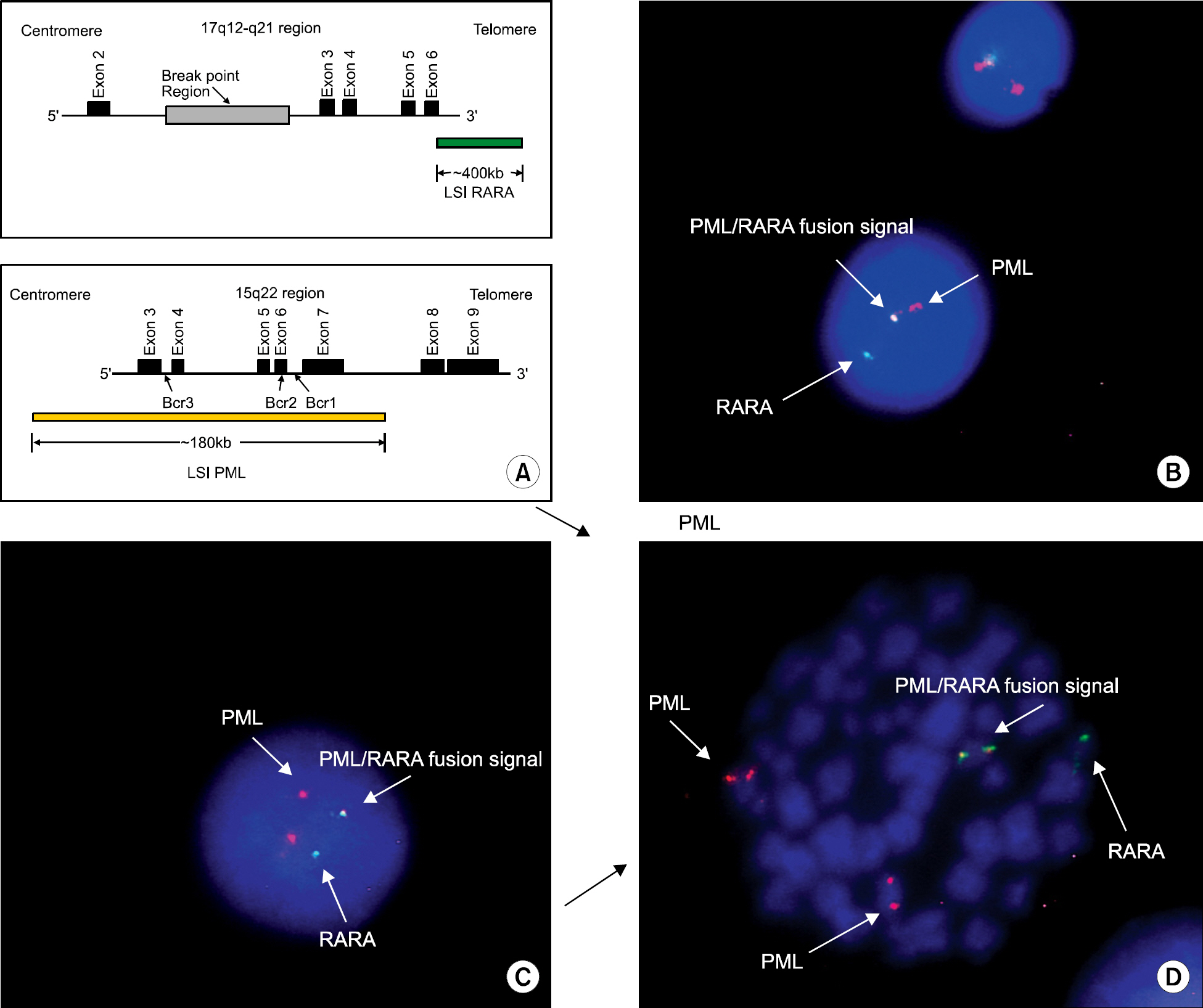Korean J Hematol.
2007 Sep;42(3):296-300. 10.5045/kjh.2007.42.3.296.
Novel PML-RARA Fusion Gene on Chromosome 17 in Acute Promyelocytic Leukemia with Normal Chromosome 15 and 17
- Affiliations
-
- 1Division of Hematology-Oncology, Department of Internal Medicine, Korea. jhwon@hosp.sch.ac.kr
- 2Department of Laboratory Medicine, Soonchunhyang University College of Medicine, Seoul, Korea.
- KMID: 2305207
- DOI: http://doi.org/10.5045/kjh.2007.42.3.296
Abstract
- We describe a patient with acute promyelocytic leukemia (APL) with no detectable cytogenetic abnormality of either chromosomes 15 or 17 who nevertheless had juxtaposition of promyelocytic leukemia (PML) and retinoic acid receptor-alpha (RARA) and expressed a chimeric transcript. Conventional cytogenetics showed the 46, XX. The metaphase fluorescence in situ hybridization (FISH) with a 5' PML and 3' RARA probe showed a juxtaposed PML-RARA fusion signal on one chromosome 17 homologue, an RARA signals on the other chromosome 17 homologue, and one PML signal on each chromosome 15 homologue. Our patient is presently in remission and doing well after chemotherapy with idarubicin and all trans retinoic acid (ATRA) treatment. Our results show that APL patients with cytogenetically normal chromosome 15 and 17 may, nevertheless, have involvement of both PML and RARA genes and as the prognostic outcome in APL is associated with the presence of a PML-RARA fusion, it is necessary to perform RT-PCR or FISH to aid diagnosis.
MeSH Terms
Figure
Cited by 1 articles
-
Detection of
PML/RARA Rearrangement by Reverse Transcriptase-PCR and Sequencing in a Case of Microgranular Acute Promyelocytic Leukemia Lacking t(15;17) on Karyotype and FISH
Kyung-Eun Kim, Kwang-Sook Woo, Sung-Hyun Kim, Jin-Yeong Han
Korean J Lab Med. 2009;29(5):379-383. doi: 10.3343/kjlm.2009.29.5.379.
Reference
-
1). Sainty D., Liso V., Cantu-Rajnoldi A, et al. A new morphological classification system for acute promyelocytic leukemia distinguishes cases with underlying PLZF-RARA rearrangements. Blood. 2000. 96:1287–96.2). Borrow J., Goddard AD., Sheer D., Solomon E. Molecular analysis of acute promyelocytic leukemia breakpoint cluster region on chromosome 17. Science. 1990. 249:1577–80.
Article3). de The H., Chomienne C., Lanotte M., Degos L., Dejean A. The t(15;17) translocation of acute promyelocytic leukemia fuses the retinoic acid receptor α gene to a novel transcribed locus. Nature. 1990. 347:558–61.4). de The H., Lavau C., Marchio A., Chomienne C., Degos L., Dejean A. The PML-RAR α fusion mRNA generated by the t(15;17) translocation in acute promyelocytic leukemia encodes a functionally altered RAR. Cell. 1991. 66:675–84.5). Morphologic immunologic, and cytogenetic (MIC) working classification of the acute myeloid leukemias. Report of the Workshop held in Leuven, Belegium, September 15-17, 1986. Second MIC Cooperative Study Group. Cancer Genetics and Cytogenetics. 1988. 30:1–5.6). Bennett JM., Catovsky D., Daniel MT, et al. Proposals for the classification of the acute leukaemias. Br J Haematol. 1976. 33:451–8.7). Grimwade D., Biondi A., Mozziconacci MJ, et al. Characterization of acute promyelocytic leukemia cases lacking the classic t(15;17): results of the European Working Party. Group Francais de Cytoge-netique, Group de Francais d'Hematologic Cellul-aire, UK Cancer Cytogenetics Group and BIOMED I European Community-Concerted Action "Molecular Cytogenetic Dignosis in Hematological Malig-nancies". Blood. 2000. 96:1297–308.8). Fujita K., Oba R., Harada H, et al. Cytogenetics, FISH and RT-PCR analysis of acute promyelocytic leukemia: structure of the fusion point in an case lacking classict (15;17) translocation. Leuk Lymphoma. 2003. 44:111–5.9). Sanz MA., Martin G., Gonzáles M, et al. Risk-adapted treatment of acute promyelocytic leukemia with all-trans-retinoic acid and anthracycline monochemo-therapy: a multicenter study by the PETHEMA group. Blood. 2004. 103:1237–43.
Article10). Inazawa J., Nishigaki H., Takahira H, et al. Rejoining between 9q+ and Philadelphia chromosome results in normal-looking chromosome 9 and 22 in Ph1-negative chronic myelocytic leukemia. Hum Genet. 1989. 83:115–8.11). Brunel V., Sainty D., Costello R, et al. Translocation of BCR to chromosome 9 in a Philadelphia-negative chronic myeloid leukemia. Cancer Genet Cytogenet. 1995. 85:82–4.
Article12). Aurich J., Dastugue N., Duchayne E., Schlaifer D., Rigal-Huguet F., Caballin MR. Location of the BCR-ABL fusion gene on the qq34 band in two cases of Ph- positive chronic myeloid leukemia. Genes Chromosomes Cancer. 1997. 20:148–54.
- Full Text Links
- Actions
-
Cited
- CITED
-
- Close
- Share
- Similar articles
-
- The t (15;17) Breakpoint of the PML Gene in Acute Promyelocytic Leukemia
- Detection of PML/RARA Rearrangement by Reverse Transcriptase-PCR and Sequencing in a Case of Microgranular Acute Promyelocytic Leukemia Lacking t(15;17) on Karyotype and FISH
- Detection of Long and Short isoforms of PML-RARA mRNA by RT-PCR in Acute Promyelocytic Leukemia
- A Case of Acute Promyelocytic Leukemia with Co-existence of BCR-ABL1 and PML-RARA Rearrangements Detected by PCR
- Utility of RARa Fluorescence In Situ Hybridization for Follow-up in Acute Promyelocytic Leukemia: Comparison with PML/RARa Fluorescence In Situ Hybridization




